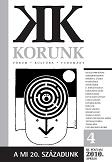Huszadik századi magyar politikai rendszerek
Twentieth-Century Hungarian Political Regimes
Author(s): Ignác RomsicsSubject(s): History
Published by: Korunk Baráti Társaság
Keywords: Hungary; political regimes; dualism; the Horthy era; state socialism; Hungarian Republic
Summary/Abstract: Hungarian history in the 20th century is made up of four largely differing periods divided by three major historical events. These were the era of dualism until 1918, the Horthy era between 1920 and 1944, the period of state socialism established after World War II and the Third Hungarian Republic in the last 20 years. In this essay the nature of the political regime of these four time periods is treated. In respect of its most essential institutions, their structures and operational principles the dualist system can be characterized as liberal. To the extent that these liberal principles were violated, this was generally related to monarchical rights. The imperial-royal sphere of authority, both in legislations and in the executive arena, was excessive, and this in turn endowed the political system as a whole with certain authoritarian stamp. In the terminology proposed by Juan Linz and Giovanni Sartori, the Horthy regime should be characterized as one of authoritarianism with predominant party relations. It was not a democratic one and it definitely cannot be said to have displayed the distinguishing marks of Fascist or National Socialist totalitarianism. After a short – more or less democratic – transitional post-war period, Soviet-type dictatorship was established in Hungary. There can be no dispute that this regime which had developed by 1949 qualifies to be called totalitarian. All power was concentrated in the hands of the sole remaining party, which both dictated and oversaw the work of parliament, government and local administration alike. In the 1960s the regime became less totalitarian and more “liberal”. However, the earlier features of the dictatorship including one-party system and communism as state ideology remained unaltered. In 1989-1990 the one-party dictatorship has been replaced by multiparty democracy. By this, Hungary was again back on the path that had originally been signposted for it a century and a half before by István Széchenyi, Lajos Kossuth and Ferenc Deák, the “founding fathers” of the modern parliamentary Hungarian state.
Journal: Korunk
- Issue Year: 2010
- Issue No: 04
- Page Range: 5-17
- Page Count: 13
- Language: Hungarian

